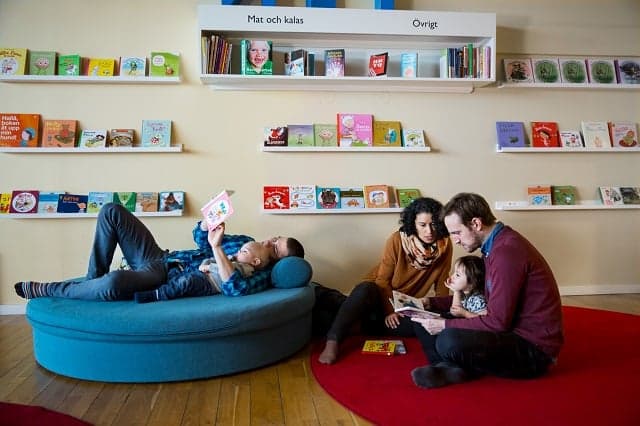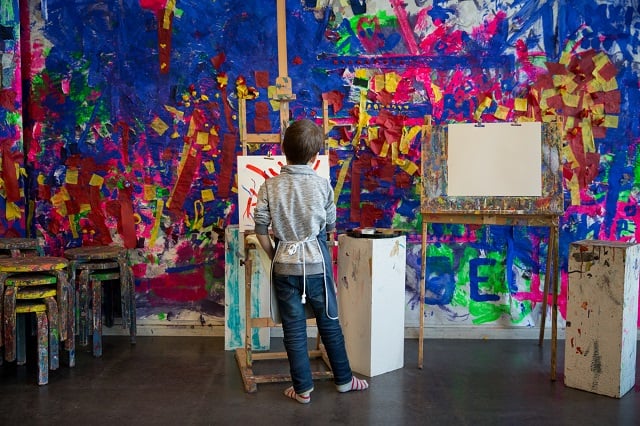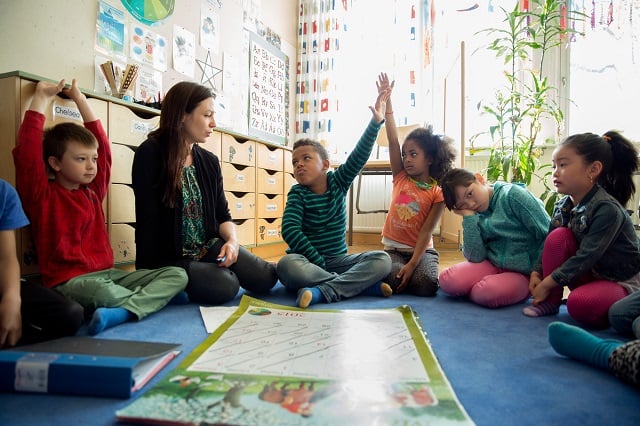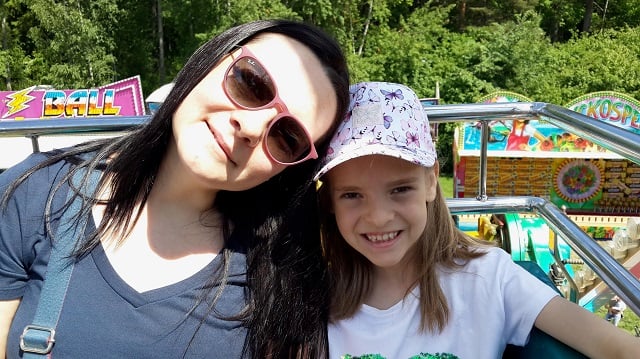Bringing up kids multilingual in Sweden: the tales of six families

In Sweden, 200 different languages are spoken and the number of multilingual families is growing. But just how do you manage it, how do the children feel, and are there any challenges? The Local spoke to six families to learn about life in more than one language.
"I've spent my whole life learning languages, and struggling to do so," says language teacher David Martinez.
Martinez is Spanish and married to an American, so for both personal and practical reasons, their children were always going to be bilingual. "We wanted them to have the advantage we haven't had," he tells The Local.
In Sweden's larger cities, it often feels like the country is bilingual. Swedes are regularly ranked among the world's best non-native English speakers; English is used on most public signage and in many adverts; and walking down a street in Stockholm, you'll hear it spoken in accents ranging from British to American to Scandinavian. There are dozens of international schools across Sweden, allowing parents to raise their children bilingually, speaking both Swedish and English.
But that's just part of the story. More than 200 different languages are spoken by the country's residents, and multilingual families are increasingly common. Seventeen percent of Sweden's population was born abroad, and a further three percent were born in Sweden to two foreign-born parents.
The Local spoke to six parents raising their children with more than one language to find out how it works and what the challenges are.
'I get frustrated if they answer in English'
In the case of the Martinez family the couple's daughter was born in the US in 2012, and by the time their son was born two years later, the family had moved to Spain. Each parent spoke to the children in their own native language, and the children had ample exposure to English and Spanish both at home and at school. But when they moved to Sweden in mid-2016, a third, new language spoken by neither parent was thrown into the mix.
Martinez says this was tough for the children, and he found it hard to watch his sociable daughter, now aged five, struggle to understand her native Swedish classmates. But in their year and a half in Sweden – which his wife Victoria writes a column about for The Local – both children have adapted well. "Once my daughter realized that speaking Swedish helps her to make friends, she really tried with it, and now she has better pronunciation than me," he says.

The family pictured in Swedish winter. Photo: Victoria and David Martinez/Private
The most difficult thing for the family is finding time to ensure they are still exposed to Spanish, since Martinez works full time. This means that occasionally the children find it difficult to revert to Spanish, or simply switch to one of their other languages.
Although it can be tough for him when the children refuse to speak in his native tongue, he says the key thing is not to force them to speak it or put too much pressure.
"Comprehension is the most important thing, so I just want them to listen to me in the language and understand. That makes it easier for them to connect words and put them in context. So if I ask them a question in Spanish, I might get frustrated if they answer me in English, but it's already really good that they understand me," he explains.
'He didn't speak at all for six months'
This is reflected in the experience of another parent of a multilingual child, Teresa Silva. Silva and her son Artur's Spanish father each spoke to their child in their own native language, and when Artur was three, the family moved to Montreal where he attended a bilingual English-French daycare. He had had plenty of contact with different languages when the family moved to Sundsvall two years later, but Swedish was entirely different from those he already knew.
For his first six months at preschool, Artur didn't speak a single word. Teachers spoke to him in English for the first two weeks before switching entirely to Swedish. It took six months, but one day the boy responded – in perfect Swedish.
Silva hadn't been worried and knew it was only matter of time. "He couldn't answer people at first, but could understand. It was really interesting to see the process, it was like he was digesting the language, and then he made progress very quickly."

File photo, not one of the children in the article. Photo: Ann-Sofi Rosenkvist/imagebank.sweden.se
Now aged ten, Artur speaks all three of his languages every day. Swedish is his 'work language', spoken at school and with friends, he uses Portuguese with his mum, and English when playing online games or watching YouTube videos. Spanish is the language he has least contact with, as his parents are separated, but when the family visit the country it only takes a few days for him to pick it up again.
"He can switch between them easily, sometimes starting a sentence in Portuguese and finishing it in English, or translating depending on who's in the conversation. It's as if they are all just one language for him, which is amazing to me because I find it takes a lot of effort!" says Silva.
She says she is not concerned about pushing her son to continue learning 'perfect' Portuguese, and has turned down offers of 'mother language' tuition offered by Swedish schools in order to give him enough time to relax and play. However, she will continue speaking her own language with Artur. "It's just natural for me to speak Portuguese with him; it's visceral, it's biological, almost," she says.
'We use sign language to connect both languages'
Akihiro, from Japan, had a similar view about his son's language development in the future. Japanese is considered a far harder language to learn to read and write than Swedish, and he says that if his son, currently aged just one year and ten months, chooses to focus on other subjects as he grows older, he isn't concerned about this as long as he can communicate well enough to talk to family in Japan.
If he chooses to study the language further, though, Akihiro will be happy to help, and the Japanese embassy also offers language textbooks to citizens who want to teach their children the language. "Until he can decide what he wants to learn, I want to give him all the possible opportunities," he says.
He and his Swedish partner Nils* live in northern Sweden and are using an unusual method for raising their toddler with two languages.

File photo, not one of the children in the article. Photo: zhudifeng/Depositphotos
Although they generally each speak their native language with their son, and encourage Japanese and Swedish friends to do the same, they also use Swedish sign language to create a bridge between both languages. Neither parent knew sign language beforehand, but have now learned the basics of 'babytecken' or 'baby sign language' and use this when speaking with their child, in the hope that this will help connect the two languages in the early stages, before their son's verbal communication develops.
"We're not so strict with sign language, for example my son uses the sign of 'hen' for all birds, so it's more general gestures," Akihiro explains.
The couple do not stick rigidly to the one-parent one-language system, so they sometimes switch language to avoid excluding others from the conversation. However, Akihiro says that although his son can already differentiate between Japanese and Swedish, he sometimes struggles to understand the non-native Swedish.
"I say easy things like 'nej nej, stoppa, sluta', but he doesn't get it. Since I realized that he doesn't understand me, I just take a deep breath and explain clearly what I want to say," he explains.
'It requires commitment'
Abdelrahman Eldesokey and his wife May Abdellatif are both native Arabic-speakers originally from Egypt, and Eldesokey says he expects reading and writing to be the biggest challenge in their family too. "This will require a lot of effort and commitment from us," he tells The Local.
After moving to Sweden for work in 2016 with their baby daughter, then aged just eight months, they decided to raise her bilingually. At home, they stick to a policy of using only Arabic – though they both also speak English – and let their daughter learn Swedish from native speakers at nursery, which she started after her first birthday.
"We read her stories and books in Arabic, and play TV shows in both Arabic and Swedish. We have noticed that the effect of the TV is insignificant in learning either language. However, books and games are really efficient and made her progress very quickly," he says.

File photo: Niclas Vestefjell/imagebank.sweden.se
They also have an Egyptian friend with a young child, and try to meet up weekly so the children can speak Arabic together, while visits to and from family provide further opportunity for practice.
But for now, the main challenge for the couple has been ensuring consistency in their daughter's Swedish language development, which was disrupted by the fact they have needed to move house several times since first arriving.
"When she started attending dagis again, she was so confused that she stopped speaking the two languages for a few weeks. But now she is developing well in both languages," he says.
'The support for multilingual families is great'
Reshmi Dutta, a native Bengali speaker who moved to Sweden from India in 2009, also uses the method of speaking only the parents' native language at home. Although her daughter was born in Sweden, from her birth Dutta has only ever spoken to her in Bengali, introducing her to Swedish only when she began nursery.
"Her level of Bengali depends completely on us, and because she's so young we need to keep speaking to her in it or she may forget what she's learned so far," she says. "I wanted Bengali to be her first language because it is my language."
By the age of one, Dutta's daughter already spoke some Bengali words clearly, and a year later when the family visited India, friends and family were impressed by how well she spoke the language. "I've even been approached by Swedish people at the tunnelbana station or on the street, and they've said it's great to see me speaking to her in our mother tongue. It's really nice to get praise for this!" she says.
The toddler now attends a Swedish-speaking nursery where she has picked up the language, as well as some English from songs and cartoons.

File photo: Ann-Sofi Rosenkvist/imagebank.sweden.se
"No one actually sat down with her and taught her Swedish, but from being exposed to the environment, her brain has absorbed it," Dutta explains. She adds that both parents are now learning Swedish from their daughter, who has picked up accurate pronunciation and often translates for or corrects her parents. After nursery, however, Dutta hopes to send her daughter to an English-speaking school to best prepare her for a international life.
Dutta works at a school herself and has been impressed by the efforts made in Sweden to support children with a home language other than Swedish. One such measure is the provision of 'mother language tuition', offered free to bilingual children who meet certain conditions, and Dutta plans to apply for this for her daughter.
One area where these classes would be particularly useful is writing, as Dutta doesn't feel confident to teach her daughter how to write in Bengali. "When I was at school, there was much less support for mother tongue languages; everything was in English, so my writing is not very good, sadly," she says. "Because of that experience, I appreciate the Swedish system so much."
'It was a nightmare at first'
Like Dutta, Natalya Pleshkova grew up bilingual, speaking both Ukrainian and Russian at home. She also says that the biggest challenge in her nine-year-old daughter's multilingual upbringing was reading and writing.
Pleshkova and her husband raised their daughter speaking Ukrainian and Russian, but the child, then aged seven, had attended school in Ukraine for just two months when Pleshkova was relocated to Sweden at short notice by her company. At her new school in Sweden, their daughter was introduced to both Swedish and English, at the exact moment when she was learning to read and write.
"That was the challenge moment!" says Pleshkova. "Starting school and learning to read is a difficult transition anyway, but she had to do this in both an old and new language. Russian and Ukrainian use Cyrillic alphabets while Swedish and English use Latin, so there are two codes to learn. It was difficult for her to discover that sounds were written completely differently in the different languages. It was kind of a nightmare in the first months!"
.jpg)
Natalya Pleshkova and her daughter. Photo: Private
"At the start she was surrounded by people who didn't understand her language and who she didn't understand. It was quite stressful and for a while she didn't even eat at school, because there were unusual foods and she wasn't able to ask what they were. I struggled then, I was rushing from work to pick her up at lunch," explains Pleshkova.
However, she says that being surrounded by Swedish-English bilingual children motivated her daughter to learn the languages, as it was the only way to talk to her classmates and make friends. She tried to stimulate her daughter's curiosity by organizing private classes with a Swedish teacher and taking her to different activities each weekend, including at children's themepark Junibacken and the Kulturhuset library in Stockholm. She also organized private classes for her daughter with a Swedish teacher, and like the other parents we spoke to, Pleshkova praised the mother tongue tuition that's often offered by Swedish schools.
Although it wasn't possible to get this in Ukrainian, the family were able to organize Russian help with lessons ([it is only possible to receive mother tongue tuition in one language at once), ensuring that their daughter's Russian has progressed even as she has learned Swedish and English from scratch.

Photo: Natalya Pleshkova/Private
As for how the family manage to balance so many languages, Pleshkova admits this is difficult, particularly as accessing Russian and even more so Ukrainian literature is tough in Sweden. She tries not to speak Swedish in case this acted as a detriment to her other languages, but said that sometimes her daughter finds it easier to understand Swedish, because of the continued exposure at school.
She says sometimes her daughter is very tired after the school day, and creates a "comfort zone" after school, playing using her first language. "I allow her to do that so she can relax and have an escape. Children might choose to only use one language for a period, and it's hard to change that."
So are there any tricks?
"You need to have patience, lots of it, and also be creative, fun, and resilient. Children learn what they like, not what they're supposed to learn."
Some names have been changed to protect privacy.
Comments
See Also
"I've spent my whole life learning languages, and struggling to do so," says language teacher David Martinez.
Martinez is Spanish and married to an American, so for both personal and practical reasons, their children were always going to be bilingual. "We wanted them to have the advantage we haven't had," he tells The Local.
In Sweden's larger cities, it often feels like the country is bilingual. Swedes are regularly ranked among the world's best non-native English speakers; English is used on most public signage and in many adverts; and walking down a street in Stockholm, you'll hear it spoken in accents ranging from British to American to Scandinavian. There are dozens of international schools across Sweden, allowing parents to raise their children bilingually, speaking both Swedish and English.
But that's just part of the story. More than 200 different languages are spoken by the country's residents, and multilingual families are increasingly common. Seventeen percent of Sweden's population was born abroad, and a further three percent were born in Sweden to two foreign-born parents.
The Local spoke to six parents raising their children with more than one language to find out how it works and what the challenges are.
'I get frustrated if they answer in English'
In the case of the Martinez family the couple's daughter was born in the US in 2012, and by the time their son was born two years later, the family had moved to Spain. Each parent spoke to the children in their own native language, and the children had ample exposure to English and Spanish both at home and at school. But when they moved to Sweden in mid-2016, a third, new language spoken by neither parent was thrown into the mix.
Martinez says this was tough for the children, and he found it hard to watch his sociable daughter, now aged five, struggle to understand her native Swedish classmates. But in their year and a half in Sweden – which his wife Victoria writes a column about for The Local – both children have adapted well. "Once my daughter realized that speaking Swedish helps her to make friends, she really tried with it, and now she has better pronunciation than me," he says.

The family pictured in Swedish winter. Photo: Victoria and David Martinez/Private
The most difficult thing for the family is finding time to ensure they are still exposed to Spanish, since Martinez works full time. This means that occasionally the children find it difficult to revert to Spanish, or simply switch to one of their other languages.
Although it can be tough for him when the children refuse to speak in his native tongue, he says the key thing is not to force them to speak it or put too much pressure.
"Comprehension is the most important thing, so I just want them to listen to me in the language and understand. That makes it easier for them to connect words and put them in context. So if I ask them a question in Spanish, I might get frustrated if they answer me in English, but it's already really good that they understand me," he explains.
'He didn't speak at all for six months'
This is reflected in the experience of another parent of a multilingual child, Teresa Silva. Silva and her son Artur's Spanish father each spoke to their child in their own native language, and when Artur was three, the family moved to Montreal where he attended a bilingual English-French daycare. He had had plenty of contact with different languages when the family moved to Sundsvall two years later, but Swedish was entirely different from those he already knew.
For his first six months at preschool, Artur didn't speak a single word. Teachers spoke to him in English for the first two weeks before switching entirely to Swedish. It took six months, but one day the boy responded – in perfect Swedish.
Silva hadn't been worried and knew it was only matter of time. "He couldn't answer people at first, but could understand. It was really interesting to see the process, it was like he was digesting the language, and then he made progress very quickly."

File photo, not one of the children in the article. Photo: Ann-Sofi Rosenkvist/imagebank.sweden.se
Now aged ten, Artur speaks all three of his languages every day. Swedish is his 'work language', spoken at school and with friends, he uses Portuguese with his mum, and English when playing online games or watching YouTube videos. Spanish is the language he has least contact with, as his parents are separated, but when the family visit the country it only takes a few days for him to pick it up again.
"He can switch between them easily, sometimes starting a sentence in Portuguese and finishing it in English, or translating depending on who's in the conversation. It's as if they are all just one language for him, which is amazing to me because I find it takes a lot of effort!" says Silva.
She says she is not concerned about pushing her son to continue learning 'perfect' Portuguese, and has turned down offers of 'mother language' tuition offered by Swedish schools in order to give him enough time to relax and play. However, she will continue speaking her own language with Artur. "It's just natural for me to speak Portuguese with him; it's visceral, it's biological, almost," she says.
'We use sign language to connect both languages'
Akihiro, from Japan, had a similar view about his son's language development in the future. Japanese is considered a far harder language to learn to read and write than Swedish, and he says that if his son, currently aged just one year and ten months, chooses to focus on other subjects as he grows older, he isn't concerned about this as long as he can communicate well enough to talk to family in Japan.
If he chooses to study the language further, though, Akihiro will be happy to help, and the Japanese embassy also offers language textbooks to citizens who want to teach their children the language. "Until he can decide what he wants to learn, I want to give him all the possible opportunities," he says.
He and his Swedish partner Nils* live in northern Sweden and are using an unusual method for raising their toddler with two languages.

File photo, not one of the children in the article. Photo: zhudifeng/Depositphotos
Although they generally each speak their native language with their son, and encourage Japanese and Swedish friends to do the same, they also use Swedish sign language to create a bridge between both languages. Neither parent knew sign language beforehand, but have now learned the basics of 'babytecken' or 'baby sign language' and use this when speaking with their child, in the hope that this will help connect the two languages in the early stages, before their son's verbal communication develops.
"We're not so strict with sign language, for example my son uses the sign of 'hen' for all birds, so it's more general gestures," Akihiro explains.
The couple do not stick rigidly to the one-parent one-language system, so they sometimes switch language to avoid excluding others from the conversation. However, Akihiro says that although his son can already differentiate between Japanese and Swedish, he sometimes struggles to understand the non-native Swedish.
"I say easy things like 'nej nej, stoppa, sluta', but he doesn't get it. Since I realized that he doesn't understand me, I just take a deep breath and explain clearly what I want to say," he explains.
'It requires commitment'
Abdelrahman Eldesokey and his wife May Abdellatif are both native Arabic-speakers originally from Egypt, and Eldesokey says he expects reading and writing to be the biggest challenge in their family too. "This will require a lot of effort and commitment from us," he tells The Local.
After moving to Sweden for work in 2016 with their baby daughter, then aged just eight months, they decided to raise her bilingually. At home, they stick to a policy of using only Arabic – though they both also speak English – and let their daughter learn Swedish from native speakers at nursery, which she started after her first birthday.
"We read her stories and books in Arabic, and play TV shows in both Arabic and Swedish. We have noticed that the effect of the TV is insignificant in learning either language. However, books and games are really efficient and made her progress very quickly," he says.

File photo: Niclas Vestefjell/imagebank.sweden.se
They also have an Egyptian friend with a young child, and try to meet up weekly so the children can speak Arabic together, while visits to and from family provide further opportunity for practice.
But for now, the main challenge for the couple has been ensuring consistency in their daughter's Swedish language development, which was disrupted by the fact they have needed to move house several times since first arriving.
"When she started attending dagis again, she was so confused that she stopped speaking the two languages for a few weeks. But now she is developing well in both languages," he says.
'The support for multilingual families is great'
Reshmi Dutta, a native Bengali speaker who moved to Sweden from India in 2009, also uses the method of speaking only the parents' native language at home. Although her daughter was born in Sweden, from her birth Dutta has only ever spoken to her in Bengali, introducing her to Swedish only when she began nursery.
"Her level of Bengali depends completely on us, and because she's so young we need to keep speaking to her in it or she may forget what she's learned so far," she says. "I wanted Bengali to be her first language because it is my language."
By the age of one, Dutta's daughter already spoke some Bengali words clearly, and a year later when the family visited India, friends and family were impressed by how well she spoke the language. "I've even been approached by Swedish people at the tunnelbana station or on the street, and they've said it's great to see me speaking to her in our mother tongue. It's really nice to get praise for this!" she says.
The toddler now attends a Swedish-speaking nursery where she has picked up the language, as well as some English from songs and cartoons.

File photo: Ann-Sofi Rosenkvist/imagebank.sweden.se
"No one actually sat down with her and taught her Swedish, but from being exposed to the environment, her brain has absorbed it," Dutta explains. She adds that both parents are now learning Swedish from their daughter, who has picked up accurate pronunciation and often translates for or corrects her parents. After nursery, however, Dutta hopes to send her daughter to an English-speaking school to best prepare her for a international life.
Dutta works at a school herself and has been impressed by the efforts made in Sweden to support children with a home language other than Swedish. One such measure is the provision of 'mother language tuition', offered free to bilingual children who meet certain conditions, and Dutta plans to apply for this for her daughter.
One area where these classes would be particularly useful is writing, as Dutta doesn't feel confident to teach her daughter how to write in Bengali. "When I was at school, there was much less support for mother tongue languages; everything was in English, so my writing is not very good, sadly," she says. "Because of that experience, I appreciate the Swedish system so much."
'It was a nightmare at first'
Like Dutta, Natalya Pleshkova grew up bilingual, speaking both Ukrainian and Russian at home. She also says that the biggest challenge in her nine-year-old daughter's multilingual upbringing was reading and writing.
Pleshkova and her husband raised their daughter speaking Ukrainian and Russian, but the child, then aged seven, had attended school in Ukraine for just two months when Pleshkova was relocated to Sweden at short notice by her company. At her new school in Sweden, their daughter was introduced to both Swedish and English, at the exact moment when she was learning to read and write.
"That was the challenge moment!" says Pleshkova. "Starting school and learning to read is a difficult transition anyway, but she had to do this in both an old and new language. Russian and Ukrainian use Cyrillic alphabets while Swedish and English use Latin, so there are two codes to learn. It was difficult for her to discover that sounds were written completely differently in the different languages. It was kind of a nightmare in the first months!"
.jpg)
Natalya Pleshkova and her daughter. Photo: Private
"At the start she was surrounded by people who didn't understand her language and who she didn't understand. It was quite stressful and for a while she didn't even eat at school, because there were unusual foods and she wasn't able to ask what they were. I struggled then, I was rushing from work to pick her up at lunch," explains Pleshkova.
However, she says that being surrounded by Swedish-English bilingual children motivated her daughter to learn the languages, as it was the only way to talk to her classmates and make friends. She tried to stimulate her daughter's curiosity by organizing private classes with a Swedish teacher and taking her to different activities each weekend, including at children's themepark Junibacken and the Kulturhuset library in Stockholm. She also organized private classes for her daughter with a Swedish teacher, and like the other parents we spoke to, Pleshkova praised the mother tongue tuition that's often offered by Swedish schools.
Although it wasn't possible to get this in Ukrainian, the family were able to organize Russian help with lessons ([it is only possible to receive mother tongue tuition in one language at once), ensuring that their daughter's Russian has progressed even as she has learned Swedish and English from scratch.

Photo: Natalya Pleshkova/Private
As for how the family manage to balance so many languages, Pleshkova admits this is difficult, particularly as accessing Russian and even more so Ukrainian literature is tough in Sweden. She tries not to speak Swedish in case this acted as a detriment to her other languages, but said that sometimes her daughter finds it easier to understand Swedish, because of the continued exposure at school.
She says sometimes her daughter is very tired after the school day, and creates a "comfort zone" after school, playing using her first language. "I allow her to do that so she can relax and have an escape. Children might choose to only use one language for a period, and it's hard to change that."
So are there any tricks?
"You need to have patience, lots of it, and also be creative, fun, and resilient. Children learn what they like, not what they're supposed to learn."
Some names have been changed to protect privacy.
Join the conversation in our comments section below. Share your own views and experience and if you have a question or suggestion for our journalists then email us at [email protected].
Please keep comments civil, constructive and on topic – and make sure to read our terms of use before getting involved.
Please log in here to leave a comment.